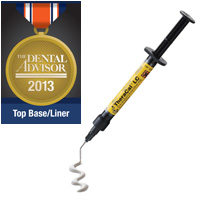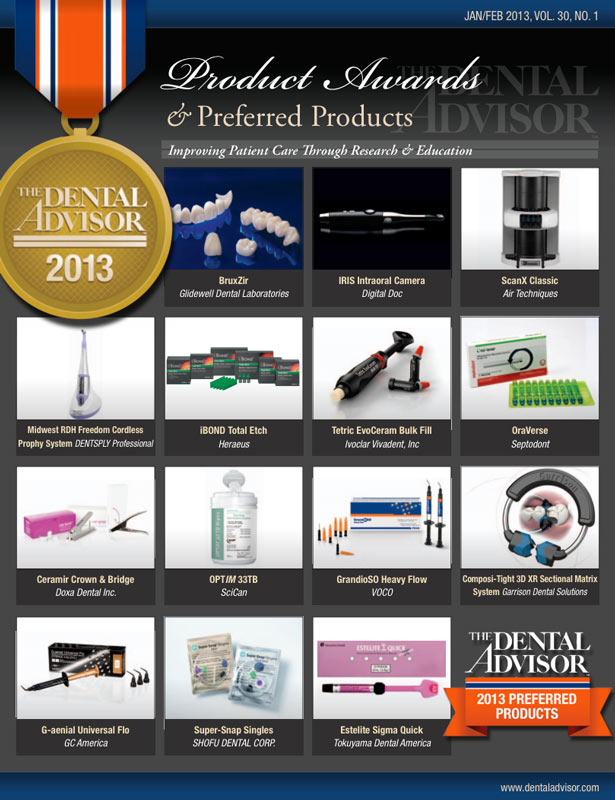Clinical Evaluations
TheraCal™ LC
Consultants’ Comments
- “I would switch – I love this product!”
- “No mixing required and it’s a one-step application.”
- “It was not as messy as other liners and it’s simple.”
- “Light-cure feature is a great advantage.”
- “I like this product; however, I found it difficult to manipulate.”
- “Somewhat difficult to place from syringe.”
Description
TheraCal LC is a light-cured, resin-modified calcium silicate material that performs as a barrier and protectant to the dental pulpal complex. It is indicated for direct and indirect pulp capping and as a protective base/liner under restorative materials including composite, amalgam and cements. The formulation consists of tricalcium silicate particles in a hydrophilic monomer that stimulates hydroxyapatite and secondary dentin bridge formation through calcium release and an alkaline pH. TheraCal LC is white in color and is radiopaque. It is supplied in a 1 g syringes. The kit contains 4 syringes of TheraCal LC with disposable application tips. TheraCal LC was evaluated by 20 consultants in 438 uses. It received a 96% clinical rating.
Clinical Observations
Packaging/Instructions
TheraCal LC is packaged in syringes that may be stored at room temperature, making it possible to keep the product in the operatory. The syringes are familiar to handle and accept universal twist-on applicator tips. Complete instructions accompany TheraCal LC, and a laminated technique card offers a pictorial guide for use in direct and indirect pulp capping. The product is so simple to use that the cards were not needed after consultants gained an initial familiarity with TheraCal LC.
Dispensing/Application
Precise, conservative placement was possible with the provided 22 gauge dispensing tips.
Clinical Procedure
Following cavity preparation, TheraCal LC is applied to the clean, dry tooth in layers of 1 mm or less. Light curing time is 20 seconds. In the case of a direct pulp cap, bleeding must be controlled by applying a cotton pellet dampened with sterile saline over the exposure. TheraCal LC must extend 1 mm beyond the exposure onto sound dentin. Restoration of the tooth with the clinician’s choice of materials may follow.
Handling
TheraCal LC has a creamy, spreadable consistency that is easy to move around yet stays in place when undisturbed. It clings to axial walls without running. Most consultants used the syringe tip, an explorer, a perio probe or a ball-tipped applicator to direct the material. The lack of bubbles was rated very good to excellent for this flowable material. Many consultants would have preferred the material to have a little more flow.
Adherence to Tooth
After light curing, TheraCal LC has a hard surface and adheres to the dentin. If excess material is present after light curing, it can be removed with a fine diamond. Filling materials can be placed immediately without disturbing the liner.
Post-operative Sensitivity
Lack of post-operative sensitivity during the evaluation period was the highest rated category. Consultants rated this excellent and will continue to monitor patients.
Appearance/Radiopacity
TheraCal LC is an opaque, white material that is very effective in masking stained dentin. Since it is used in deeper areas of the tooth, there is no negative effect on the esthetics of the final restoration. Post-operative images confirm that TheraCal LC is radiopaque, making it readily apparent.
SUMMARY
TheraCal LC provides an easy-to-use material for pulpal protection. The material integrates well into the clinical procedure, handling much like a flowable composite. Consultants were optimistic about the potential regenerative properties of TheraCal LC and found the short-term lack of sensitivity to be excellent. All consultants who evaluated TheraCal LC were currently using a traditional calcium hydroxide paste or glass ionomer liner. Ninety percent of consultants rated TheraCal LC better than their current pulp capping and base/liner material and 5% rated it equivalent. Ninety percent would switch to TheraCal LC and 100% would recommend it to a colleague.
Clinical Tips
-
Use a small tip applicator or instrument for tight spots.
-
Use in 1 mm increments.



